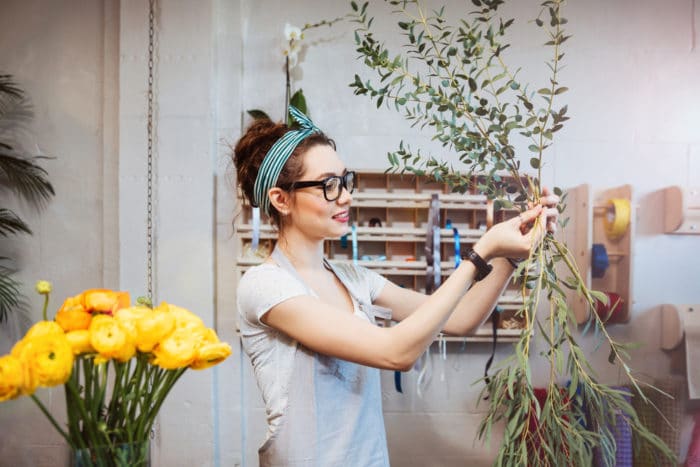Why We Love It
-
$27,010Potential Avg. Salary
-
-3.4%Job Growth Rate
-
Creativity FocusedCareer Attribute
-
Green JobsCareer Attribute
Florists and floral designers grow, cut, sell, and arrange flowers and other decorative plants. They commonly work in florist shops, gardening centers, or greenhouses. They take care of plants to promote plant growth, sustainment, and health, and they help customers choose or create floral arrangements.
Recommended Schools
What is a Florist or Floral Designer?
The following job responsibilities are common for individuals in florist and floral designer roles:
- Grow flowers and other decorative plants that can be sold individually or in arrangements
- Create custom and templated floral arrangements that can be sold to customers
- Affix bows, choose vases, and bind arrangements to cater to different uses of arrangements
- Take orders from customers in person, online, and over the phone, and arrange for delivery of arrangements to recipients
- Order flowers from wholesalers and store flowers in areas that promote longevity
A Day in the Life
Florists and floral designers specialize in growing plants and designing arrangements that can be used for decoration, to express sentiment when gifted, or as accessories for wedding ceremonies. Some work in greenhouses and other gardening centers and specialize in growing flowers and plants that can be sold wholesale to florist shops. Others work in florist shops and specialize in designing arrangements for customers, helping customers choose flowers, and delivering arrangements to recipients.
Floral designers create both custom and predesigned arrangements for a variety of occasions. They may create arrangements for parties, weddings, funerals, and holidays like Mother’s Day or Valentine’s Day. In some cases, the customer may choose from a selection of predesigned arrangement templates from a catalog, and in other cases, the designer may create custom arrangements using flowers and colors chosen by the customer. The designer affixes bows, chooses vases, and binds flowers together to create a finished piece that meets the needs of customers.
While many floral designers work with fresh flowers and plants, others specialize in creating artificial flower arrangements that customers purchase for decorating their homes. They may create arrangements that can be displayed in vases, or they may create wreaths, ropes and vines, or hanging arrangements. These designers may work in craft stores or for home decoration retailers, or they may sell their arrangements at craft fairs or online on sites like Etsy.
Typical Work Schedule
Most florists and floral designers work full-time schedules, but the hours and shifts worked may vary greatly by employer. Self-employed florists and floral designers may be able to set their own schedules. Those that work in gardening centers may work seasonally. Those that work in floral or retail shops may be required to work evening or weekend shifts. Florists may also be required to work overtime during busy times around holidays like Mother’s Day and Valentine’s Day.
Typical Employers
The majority of florists and floral designers are employed to work in—or operate their own—florist shops. Others are hired to work for grocery stores with floral departments, for gardening shops and centers, and for greenhouses or other plant distributors.
Recommended Schools
How To Become a Florist or Floral Designer
There are a few different ways you can pursue becoming a florist or floral designer. The first requires only a high school diploma. After graduating from high school, you can take on an internship, entry-level, or apprenticeship position under an experienced florist or floral designer and learn the best practices of the job through hands-on training. This is an effective approach if you are able to find a florist who’s willing to take on an apprentice, but many will prefer to work with experienced florists.
If you’re struggling to find an apprenticeship, you may be able to increase your chances of finding work by earning a certificate in floral design or a related program from a trade or vocational school. These programs teach students the basics of growing and caring for flowers and plants, as well as plant identification and popular arrangement design techniques. With a certificate that shows you’ve had professional training, it may be easier to find work in the field after graduation.
The third path is more for individuals who want to operate their own floral distribution businesses or florist shops. Some colleges offer associate’s and bachelor’s degrees in floral design that add business courses to the curriculum as well as floral care and design coursework. These degrees can be very beneficial to entrepreneurial florists and floral designers because it allows them to learn the basics of operating a business as well as the concepts and best practices of floral care and floral design.
Florist or Floral Designer Salary Data
We’ve provided you the following to learn more about this career. The salary and growth data on this page comes from recently published Bureau of Labor Statistics data while the recommendations and editorial content are based on our research.
National Anual Salary
Low Range
$20,590Average
$27,010High Range
$38,660National Hourly Wage
Low Range
$10/hrAverage
$13/hrHigh Range
$19/hrHow do Florist or Floral Designer salaries stack up to other jobs across the country? Based on the latest jobs data nationwide, Florist or Floral Designer's can make an average annual salary of $27,010, or $13 per hour. This makes it an Above Average Salary. On the lower end, they can make $20,590 or $10 per hour, perhaps when just starting out or based on the state you live in.
Salary Rankings And Facts
#744 Nationally for All Careers
Programs and Degrees
Here are the most common degrees for becoming a Florist or Floral Designer. a is usually recommended and specifically a degree or coursework that prepares you for the particular field, see below.
Highest Education Among Florist or Floral Designers
- 1.4% Doctorate
- 8.7% Masters
- 47.4% Bachelors
- 12.7% Associates
- 17.6% College
- 9.8% High School
- 2.3% Less than High School
Job Growth Projections and Forecast
2014 Total Jobs
58,7002024 Est. Jobs
56,700Job Growth Rate
-3.4%Est. New Jobs
-2,000How does Florist or Floral Designer job growth stack up to other jobs across the country? By 2024, there will be a change of -2,000 jobs for a total of 56,700 people employed in the career nationwide. This is a -3.4% change in growth over the next ten years, giving the career a growth rate nationwide of Below Average.
Growth Rankings And Facts
#678 Nationally for All Careers
What Companies Employ The Most Florist or Floral Designers
| Industry | Current Jobs | New Jobs Needed | % Increase |
|---|---|---|---|
| Florists | 28,500 | -3,000 | -3% |
| Self-employed workers | 13,600 | 400 | 0% |
| Grocery stores | 7,700 | 400 | 0% |














